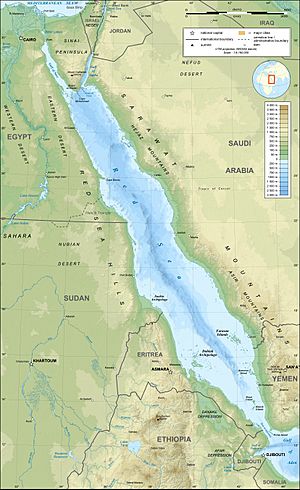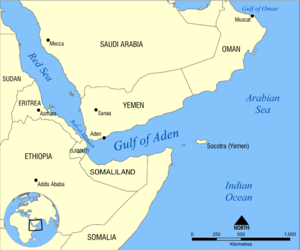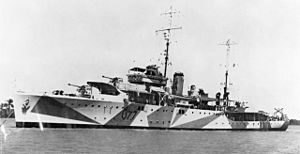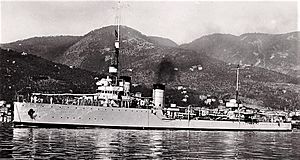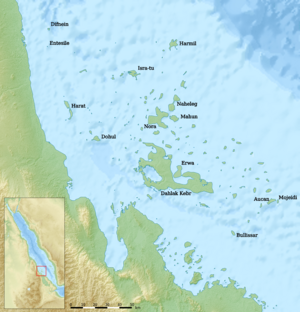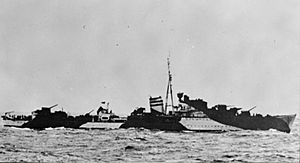Attack on Convoy BN 7 facts for kids
Quick facts for kids Attack on Convoy BN 7 |
|||||||
|---|---|---|---|---|---|---|---|
| Part of The Second World War | |||||||
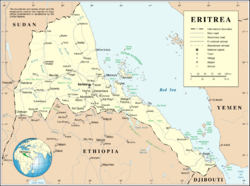 Eritrea, showing Massawa (Mitsiwa'e) and Harmil Island to the north-east |
|||||||
|
|||||||
| Belligerents | |||||||
| Commanders and leaders | |||||||
| James Rivett-Carnac J. S. M. Richardson H. E. Horan |
Costantino Borsini † Adriano M. D. Adimari Paolo Aloisi |
||||||
| Strength | |||||||
| 1 light cruiser 1 destroyer 3 sloops 2 minesweepers Convoy BN 7 (32 ships) |
|
||||||
| Casualties and losses | |||||||
| 3 wounded 1 destroyer damaged 1 merchant ship damaged |
14 killed 1 destroyer sunk |
||||||
The Attack on Convoy BN 7 was a naval battle during World War II. It happened in the Red Sea on October 20–21, 1940. British ships were protecting a group of merchant ships (a convoy) from an attack by Italian destroyers.
The Italian attack did not succeed. Only one merchant ship was slightly damaged. After a chase, the British destroyer HMS Kimberley sank the Italian destroyer Italian destroyer Francesco Nullo. Kimberley was then hit and damaged by Italian guns on Harmil Island. The cruiser HMS Leander had to tow Kimberley to safety.
Contents
What Happened?
The Italian navy tried to attack the convoy by splitting their ships into two groups. This helped them find the convoy but made their attack weaker. They lost a destroyer and didn't damage any important ships. The British leaders thought their own ships (except Kimberley) weren't aggressive enough. However, chasing enemy ships at night and in foggy weather was very risky. The Italians tried other attacks later, but they also failed.
Why Was the Red Sea Important?
The Red Sea is a very hot and humid area. Its coasts have deserts and tall mountains. Sailing there is tricky because of hidden reefs and strange mirages.
In 1939, French and British military leaders met to plan how to control the waters around Italian East Africa if Italy joined the war. They expected Italy to block the Mediterranean Sea. This meant supplies for the Middle East would have to go through the Red Sea. It was very important to control the Gulf of Aden, the Red Sea, and the Gulf of Suez. Naval bases at Aden and French Somaliland (Djibouti) were also key.
The British port of Port Sudan was on the west coast of the Red Sea. The Italian port of Massawa in Eritrea was further north. The British planned to blockade Italian ports to stop supplies from reaching them. Allied merchant ships would travel in escorted groups called convoys. Warships would clear mines, patrol the area, and protect Aden from Italian attacks. They also planned to attack Italian naval bases in Eritrea.
In April 1940, the British Royal Navy created the Red Sea Force. This force included several cruisers, destroyers, sloops, and minesweepers. Their main base was Aden.
The Italian navy also had a force in East Africa, called the Red Sea Flotilla. Their main base was Massawa. This port was well-protected by islands, reefs, and mines. The Italian ships included powerful destroyers like Pantera and Leone. These ships had many guns and could carry torpedoes and mines. However, the Italian ships faced problems. They had limited fuel because of the British blockade. Also, the hot climate and mechanical issues made it hard for them to operate often.
Before the Battle: Convoys and Attacks
In June 1940, four of Italy's eight submarines in the Red Sea were lost. The Italian air force (Regia Aeronautica) also started flying missions over the Red Sea. On June 16, an Italian submarine sank a Norwegian oil tanker.
The British started organizing convoys to protect their merchant ships. Convoy BN 1, with six oil tankers and three cargo ships, gathered in July. Italian planes often tried to find and attack these convoys. For example, on September 4, Italian bombers badly damaged a ship called SS Velko.
Italian destroyers and submarines also went out to find convoys, but they often failed. They relied on reports from spies and air patrols. Even when they found convoys, they often couldn't attack them successfully. For example, Convoy BN 5, with 23 ships, was spotted, but Italian ships couldn't find it.
Convoy BN 7 Sets Sail
Convoy BN 7 was a group of 32 merchant ships from different countries, heading north through the Red Sea. It was protected by the light cruiser HMS Leander, the destroyer Kimberley, and several sloops and minesweepers.
On October 19, as Convoy BN 7 neared Perim Island, an Italian aircraft dropped bombs near one of the ships. Leander and Auckland fired at the plane. The next morning, Italian planes dropped more bombs, but they missed the convoy. As night fell, Leander took a position between the convoy and the Italian base at Massawa to protect the ships. The convoy sailed in a zig-zag pattern through the night to make it harder for enemies to hit them.
The Battle Begins!
On October 20, the Italian destroyers sailed out. They split into two groups. The first group, Sauro and Francesco Nullo, was faster. The second group, Pantera and Leone, was slower but had more weapons. Their plan was for the second group to distract the British escort ships, then attack the convoy with torpedoes.
At 9:15 PM, the two Italian groups separated. At 11:21 PM, Pantera saw smoke from the convoy. Pantera signaled Sauro and moved to intercept the convoy. Leone followed close behind.
At 2:19 AM on October 21, Leander spotted two patches of smoke. Auckland reported two destroyers about 4 miles away. Leander changed course to intercept them, guessing they would try to escape through a channel near Massawa. Pantera fired at the convoy, causing minor damage to a lifeboat. Auckland fired back, and the Italian ships turned away at full speed towards Massawa, firing their rear guns. Pantera fired four torpedoes, but Yarra avoided them.
Meanwhile, Sauro and Nullo had also spotted Leander at 1:48 AM. Sauro fired a torpedo at Leander, but it missed. Leander fired back but lost sight of Sauro. Sauro tried another torpedo attack and then turned towards Massawa. Nullo had a problem with its rudder and couldn't attack, so it headed towards the Italian shore guns on Harmil Island.
When the shooting stopped, Leander went to intercept the Italian ships at the South Massawa Channel. At 2:45 AM, Leander fired at a ship that was shooting red and green tracer flares. The ship moved away and was soon lost in the dark.
Leander then spotted Nullo with its searchlight and they exchanged fire for about ten minutes. Leander hit Nullo several times, damaging its navigation and gun control systems. At 2:51 AM, Leander lost sight of Nullo in the haze. Nullo headed for Harmil Island, with Leander chasing it. At 3:00 AM, Leander found Kimberley, which was also chasing Nullo. After five minutes, Leander turned back to rejoin the convoy, as Nullo was getting away too fast, and the convoy still needed protection.
The Chase to Harmil Island
In the early morning of October 21, Kimberley continued its chase at top speed. At 3:50 AM, it saw smoke ahead. At 5:40 AM, near Harmil Island, Kimberley and Nullo spotted each other. Nullo was surprised when Kimberley opened fire at 5:53 AM. Kimberley got closer and hit Nullo several times.
At 6:20 AM, Nullo scraped a reef, damaging a propeller and causing a leak. As Nullo went around Harmil Island, it was hit twice more, losing all power. The captain, Borsini, ordered the crew to abandon ship and tried to run Nullo aground on the island. Nullo was then hit by a torpedo at 6:35 AM, which broke it in two. Captain Borsini and his assistant chose to stay with the ship and were lost.
At 6:15 AM, four large guns on Harmil Island started firing at Kimberley. One shell hit Kimberley's engine room, wounding three sailors and damaging its steam pipes. Even though it was damaged and drifting, Kimberley fired back and silenced two of the Italian guns.
Kimberley managed to get moving again, but at a much slower speed. The shore guns stopped firing when Kimberley moved further away. Leander left the convoy and sped towards Kimberley. By 8:25 AM, Leander was near Kimberley. Kimberley had lost water in its boilers, so Leander sent a boat with engineers to help. A wounded sailor was also moved to Leander for medical care. Around 10:00 AM, Leander began towing Kimberley.
What Happened Next?
Of the 120 crew members on Nullo, 12 were killed. The other 106 were rescued by sailors from Harmil Island. Kimberley was out of action until October 31 and needed full repairs later.
At 10:00 AM on October 21, Leander fired at three Italian aircraft that bombed near the ship, but no damage was done. Leander and Kimberley rejoined Convoy BN 7 just after noon. Later that day, Leander handed the tow of Kimberley over to the destroyer Kingston. Kingston took Kimberley to Port Sudan for repairs.
Later on October 21, three British Blenheim bombers found and bombed the wreck of Francesco Nullo. The Italians tried other attacks in December and January, but they were also unsuccessful.
Another Attack: Convoy BN 14
On the night of February 2–3, 1941, Italian destroyers Pantera, Tigre, and Sauro sailed from Massawa to attack another convoy, BN 14. This convoy had 39 merchant ships and was protected by a cruiser, a destroyer, and two sloops.
Sauro found the convoy and fired torpedoes, then turned away. The other Italian ships didn't get Sauro's message, but Pantera saw the convoy ten minutes later and fired torpedoes. The Italians thought they hit two merchant ships, but this was a mistake. Tigre couldn't find the convoy at all. Near Massawa, Sauro ran into Kingston but had no torpedoes left. The Italian ships then gathered together and called for air support, reaching port safely.
See Also


